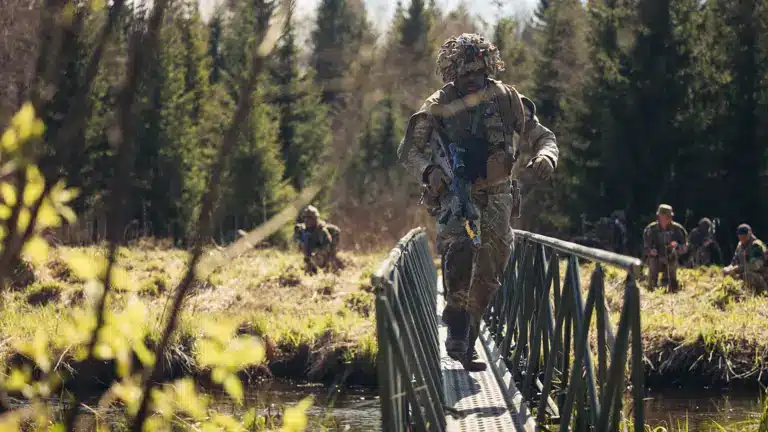Over 3,000 British Army troops have shown their support for a NATO ally as a major multinational exercise ends.
Exercise Hedgehog has seen 17,000 troops from 12 NATO allies and partner nations, help assess the combat readiness of the Estonian armed forces.
As well as testing the ability of the Estonian Defence Forces and Estonian Defence League units to respond to potential attack by Russia, the exercise has practiced the rapid and large-scale deployment of allied forces to Estonia.
Led by the British Army’s 4th Light Brigade Combat Team, ‘The Black Rats’, thousands of troops travelled from the UK to Estonia by road, rail, sea and air in less than 48 hours. The mass transit of troops demonstrated the British Army’s ability to rapidly deploy a large-scale force to support a NATO ally that borders Russia.
Exercise Hedgehog 25 is the first time the UK’s 4th Light Brigade, which is assigned to Estonia under NATO, fully integrated into the Estonian division. The brigade is kept at high readiness in the UK to reinforce Estonia in the event of crisis and conflict.
The main combat activities of the exercise took place in northeastern Estonia at a training area close to the Tapa military camp and in southeast Estonia at the Nursipalu training area.
The 1st Battalion The Duke of Lancaster’s Regiment (1 LANCS) and the 2nd Battalion of The Royal Regiment of Scotland (2 SCOTS) formed Battlegroups in the Nursipalu training area where they carried out urban and woodland combat training.
British troops built trenches in the Estonian forest, along the same lines as those dug by soldiers in Ukraine to defend against Russia’s invasion. Attacking forces from other NATO allies assaulted the trench positions using drones with simulated pyrotechnic munitions, blank ammunition fired by machine guns and simulation grenades.
Lieutenant Colonel Robert Carman, Commanding Officer, 1 LANCS, said:
“The 1 LANCS Battlegroup is a key part of 4th Light Brigade’s Forward Land Forces. We have deployed on Exercise Hedgehog as a mission rehearsal, showcasing our ability to rapidly commit forces to the region, and demonstrating NATO’s readiness to respond against threats to member states.
“During this operationally focused exercise, we integrated with our Estonian and NATO allies and enhanced our ability to operate in a challenging environment. Our soldiers focused on defence, fighting in woods and forests, and embraced new technology at the forefront of Army modernisation, which includes cutting edge drones, communications, and weapon systems.
“After Exercise Hedgehog finishes, I expect the Battlegroup to continue building relationships with our Estonian partners, supporting the commitment to persistent presence throughout the region.”
Over 100 miles to the northeast of Nursipalu, further combat training with 6,000 troops took place in the densely wooded forests of the central training area near NATO’s Tapa Camp, 17 kilometres long and 7 kilometres wide.
Challenger 2 main battle tanks, Warrior armoured fighting vehicles, Apache attack helicopters, drones, the Archer wheeled artillery system, a multiple launch rocket system (MLRS), the Trojan armoured mine clearance sweeper and the Titan armoured bridge launcher formed a devastating British Army arsenal of fighting capabilities that contributed to a realistic battle scenario.
Lieutenant Colonel Grant Brown, Commanding Officer, 1st Battalion The Mercian Regiment and Commander of the 1 MERCIAN Battlegroup in Estonia said:
“The exercise has proved really useful for improving our own training level. As a multinational Battlegroup commanding a French company, it has made us more interoperable with the French and the Estonian headquarters.
“The huge number of drones above us, clearly a threat in modern warfare, has proved challenging but also an amazing opportunity to train against that threat.”
Over 500 troops from 1 MERCIAN took part in the exercise but Lieutenant Colonel Brown was keen to stress the contribution of the other UK force elements that made up the Battlegroup and took its total composition to over 800 troops:
“When you add this to the roughly 230 French troops, we’ve got a sizeable force package out here. This includes 19 Regiment Royal Artillery, the King’s Royal Hussars, 2 Medical Regiment and 26 Engineer Regiment. There’s a number of people that all come together and that’s essentially what a Battlegroup is. While 1 MERCIAN is the name, we simply form the core that brings a whole raft of capabilities around it.”
Lieutenant Colonel Brown spoke directly to people back in the UK:
“I think a lot of people underestimate the threat that faces us every day. Part of us being out here is not necessarily always to deter but to reassure our allies and to better train alongside them and to show all the nations that form part of NATO that we stand as one. That is key, we are far stronger together than we are alone.”
The Estonian Defence League is a voluntary national defence organisation, managed by the Estonian Ministry of Defence, organised in accordance with military principles, possesses weapons and holds exercises of a military nature.
The 12 countries that took part in Exercise Hedgehog were Estonia, the United Kingdom, the United States, Canada, France, Germany, Denmark, Sweden, Latvia, Finland, Poland and Portugal.
Observers and instructors from Japan, Israel and Ukraine also attended.
The 1 MERCIAN Battlegroup is the resident Battlegroup in Estonia, based at Tapa Camp, that rotates every six months and is embedded in the 1st Estonian Brigade as one of their major manoeuvre units.
Exercise Hedgehog is one of several activities taking place in Northern Europe over the next few weeks under the banner of Operation Razoredge, supporting NATO’s eastern flank. In total, 13 NATO allies will carry out exercises in six countries with 16,500 allied troops and 6,000 UK troops.

